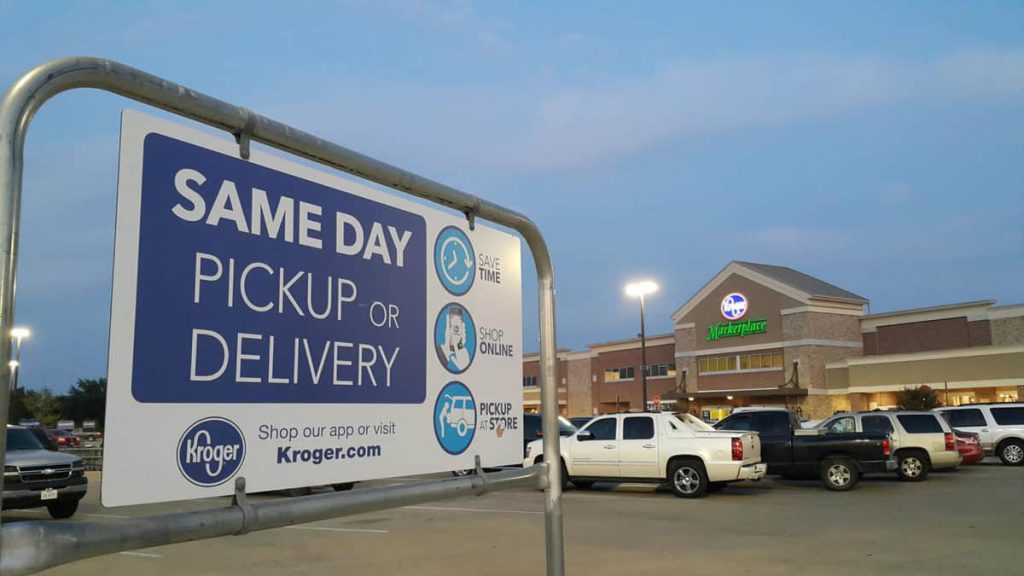
By Linda Baker
As demand for touchless delivery soars, parking spaces — and parking lots — are getting a makeover, transforming places for cars into logistics hubs serving distributors and their customers.
Grocery store lots are a focal point, but other types of parking spaces are also getting a rethink as the coronavirus pandemic prompts companies and cities alike to implement measures that limit the number of people who mix in enclosed spaces.
The idea of a grocery store as a terminal — instead of a consumer shopping center — is likely to gain traction as a result of the pandemic, said Anne Goodchild, director of the Urban Freight Lab, a public/private partnership at the University of Washington in Seattle that works to find solutions to urban delivery challenges.
In a typical warehouse, workers are the only ones to enter and exit, while strangers are prohibited from going inside. Drawing a comparison with post-9/11 safety measures, Goodchild noted that the terrorist attacks led airports to close off departure gates to everyone but the passenger, and that simultaneously many ports began to deny entry to truckers.
“A lot of that literature is now going to be used in stores,” she said.
Retail moves outside
Even before the pandemic, of course, large retailers such as Walmart (WMT) and Kroger (KR) were offering curbside grocery pickup. E-commerce is rooted in the premise of stores as warehouses, not brick-and-mortar shopping outlets. And Amazon (AMZN) stretched the definition of a traditional supermarket a couple of years ago, when it began locating its storage lockers in Whole Foods Markets.
Those store-as-logistics facility trends are accelerating as grocers limit the number of customers and store hours to ensure social distancing and time for cleaning, turning grocery shopping (for many, a pleasurable activity) into a grim slog that evokes the gas lines that prevailed during the oil crises of the 1970s.
But even as food shoppers suffer through the supply chain disruptions caused by COVID-19, novel logistics solutions are going mainstream.
One iteration is to do curbside grocery pickup at a neighborhood scale — a practice long used by local food suppliers such as community-supported agriculture and farmers markets. Bringing everyone’s groceries to a convenient neighborhood location, with shoppers picking up the items from there, is more efficient and cost effective than one-on-one Instacart shopping, or having each shopper travel a long distance to a supermarket.
A case in point: REEF Technology, an Urban Freight Lab partner whose tagline is “parking, much more than a space to store your car,” is working on a new convenience store proposition in Miami that would allow shoppers living within a three-mile radius to pick up their orders from the company’s parking facilities, where the stores will be located. Delivery is another option.
The new grocery option “offers a unique advantage” of being in very close proximity to the consumer, according to spokesperson Katy Feinburg, unlike traditional large grocers that are generally on the outskirts and/or serve a much larger radius.
Miami-based REEF operates 5,000 parking lots and garages around the country, as well as a network of mobile food kitchens. The company is getting ready to launch 15 additional convenience stores over the next two weeks, including in New York, Baltimore, Minneapolis, Dallas and Portland, Oregon, Feinburg said.
It is also working to transform its parking network into coronavirus testing sites and delivery hubs for essential goods and services.
Everything old is new
That parking lots would serve as food delivery sites is not in and of itself a new idea. Goodchild grew up in Canada, where, she said, customers would order beer at a store, then go outside where the beer came out on a conveyor belt. Many big box stores, IKEA for example, already use that kind of model for bulky or oversize items.
Fueled by a surge in e-commerce that predated the coronavirus, these delivery models are getting a kick from the unprecedented outbreak. “There are a lot of models that are being kind of translated or reconsidered for how we do that last shopping piece,” Goodchild said.
For some time now, cities have been reimagining curbside parking zones as diverse urban spaces, suitable for restaurant seating as well as ride-sharing vehicles. Now, taking advantage of a highly unusual situation — an abundance of street parking stemming from coronavirus lockdowns — the Seattle Department of Transportation has come up with another option, commandeering vehicle parking spaces to establish special food delivery pickup zones for restaurants at over 200 locations.
“With these temporary changes, we are able to quickly reprioritize the curb to ensure there is space to support the needs of these establishments as they strive to remain vital and open during these challenging times,” a city of Seattle spokesperson told FreightWaves.
In times of crisis, cities and companies pivot quickly. Over the weekend Amazon announced it was converting a Whole Foods Market in Woodland Hills, California, into a temporary location for filling only online grocery orders for delivery. No retail shoppers allowed.
It’s possibly one more step toward a future in which people interact and select the products they want, “but we don’t have them physically interact with the goods or with each other,” Goodchild said.